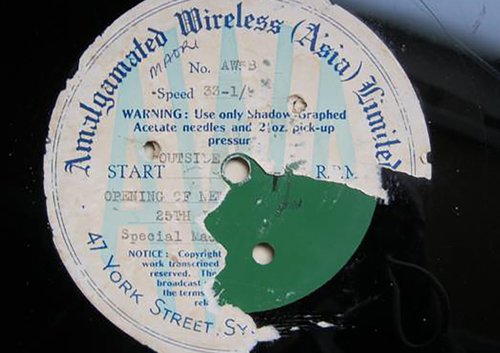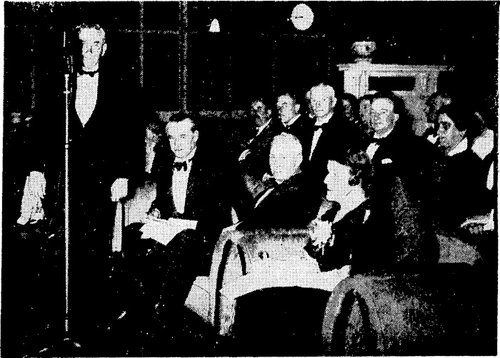
By Sarah Johnston
If you have driven into Wellington from the Kāpiti Coast you will probably know the sight of the RNZ transmission mast that used to dominate the skyline at Tītahi Bay near Porirua. This week the last section of the big 220-metre mast was finally demolished after it was found to have significant rust damage. There has been a radio mast at Tītahi Bay since 1937. When it was built, the original mast was the tallest structure in New Zealand and remained so until the Auckland Sky Tower was built in the 1990s.
Recordings held in the radio collection of Ngā Taonga Sound & Vision tell us about the important role this mast played in New Zealand’s broadcasting history. They were made at the opening ceremony for the transmitter – the fact the ceremony was recorded and archived is indicative of the significance of this event in 1937. You can hear me talking about these recordings with Jesse Mulligan on RNZ National here , or you can listen to the original recordings in full below.
Radio began in New Zealand in the mid-1920s and station 2YA (which eventually became RNZ National) used to broadcast from Mt Victoria. But after the Hawke’s Bay earthquake in 1931 it was decided that a station with enough power to be heard nationwide was needed, so the government bought the Tītahi Bay site and built what was then the most powerful station in the southern hemisphere.
Ngā Taonga Sound & Vision holds several discs recorded at the opening ceremony for the new transmitter on 23 Jan 1937. Prime Minister Michael Joseph Savage was there and in his speech he stressed the importance of this new medium of radio, saying: “Radio will soon be as necessary for the mind of an active citizen as water is for the human body”.
Hero image: A close-up of the disc of the 1937 Māori concert, which survived the 1942 Wairarapa earthquake, showing damage to its label (Ngā Taonga Sound & Vision collection).
Prime Minister M.J. Savage at the opening of 2YA transmitter, 25 January 1937.

Rt Hon M.J. Savage (left) declaring the new 60-kilowatt transmitting station at Tītahi Bay officially opened. (Evening Post, 26 Jan 1937 - Courtesy Papers Past )
Mr Savage had already grasped how radio could be used to promote democracy. In 1936 New Zealand had become one of the first countries in the world to broadcast parliament, so this new transmitter that could reach the whole country tied in with his push to strengthen the spread of radio in New Zealand.
The transmitter buildings are Art Deco in style and very evocative of the 1930s era. When Ngā Taonga Sound & Vision built a new secure storage facility on the site recently to house flammable nitrate film, the new building was deliberately designed to tie in with the historic Art Deco RNZ transmitter buildings.

RNZ Titahi Bay transmitter buildings. (Image courtesy of RNZ )

RNZ Titahi Bay transmitter buildings. (Image courtesy of RNZ )
The opening ceremony at the transmitter site was quite an event. As the newspaper photo above shows, black tie was the dress code for the evening. After speeches were made by the Prime Minister and the Director of Broadcasting, Professor James Shelley, a Māori Concert Party performed with a live orchestra – the 2YA “Orchestrina.” The concert party were a group from Whanganui, led by Herewini Metekingi and they had been involved in radio broadcasts for a quite a few years already. They took part in one of the most ambitious events in early New Zealand broadcasting , an elaborate “Pageant of Māori History,” which was broadcast on Waitangi Day in 1928 . Unfortunately we don’t have any recordings of this – or any radio broadcasts in New Zealand from the 1920s and early 1930s. This is because the Broadcasting Service didn’t have recording equipment until 1935, when they purchased some disc recorders from overseas. Before then, all radio broadcasts simply went out live-to-air.
This means these recordings made in January 1937 are probably our oldest recorded Māori radio broadcasts.
The original discs recorded at the 2YA transmitter opening ceremony are held in the radio collection of Ngā Taonga Sound & Vision and have been digitised. Unfortunately, the disc of the Māori concert is not a good quality recording, suffering from variations in recording speed when it was made. However, a second private recording of the concert broadcast was made that evening in 1937, and how it came to be in our collection is an interesting story in itself.
It is not known who made this second disc recording. Careful listening reveals the sound quality is that of an “off-air” broadcast: i.e. it was not recorded at the concert itself, but rather it is of the broadcast as it was received by a radio, complete with the some atmospheric disturbance and even the occasional faint Morse signals. As disc recording equipment was still not very common in New Zealand in early 1937, it may have even been recorded by the Amalgamated Wireless company of Sydney, whose label is on the disc.
2YA’s powerful signal was often picked up by listeners in Australia. Amalgamated Wireless (later AWA Ltd) was a pioneer in manufacturing and distributing radio equipment and discs, and supplied the original Tītahi Bay aerial and transmitter, so they may have made the recording to see how their equipment was working.
This disc was donated to the New Zealand Broadcasting Corporation in 1967 by Mr H.J. Nicholls of Palmerston North. We also have the letter he wrote, explaining how he found the disc in 1942 in a badly earthquake-damaged house in Wairarapa. The house was condemned following a 7.2 quake and the disc was rescued after being found on a table surrounded by bricks and rubble. How it ended up in Wairarapa though, remains a mystery.
The Māori concert set-list features several waiata popularised during World War I by the Māori Contingent and the fund-raising concerts organised by Sir Apirana Ngata and Paraire Tomoana. Songs such as “E Pari Rā,” “Te Ope Tuatahi” and “Hoea rā te waka nei” would have been familiar to both pākehā and Māori listeners of 1937, as would well-known tunes such as “Pōkarekare ana” and “Hine e Hine” – or “The Slumber Song,” as it is introduced.
An interesting feature of the concert is the waiata “Tītahi Bay, Pōneke,” which Mr Metekingi introduces as having been written especially for 2YA, “the national station.”
This recording of the concert ends part-way through Alfred Hill’s “Home, Little Māori Home,” a very popular tune from 1911 that was also part of the repertoire of early Māori recording artists such as Ana Hato and the Rotorua Māori Choir.
Audio clips are from Ngā Taonga Sound & Vision’s Radio Collection, all rights reserved. To enquire about re-use of these items please contact us.